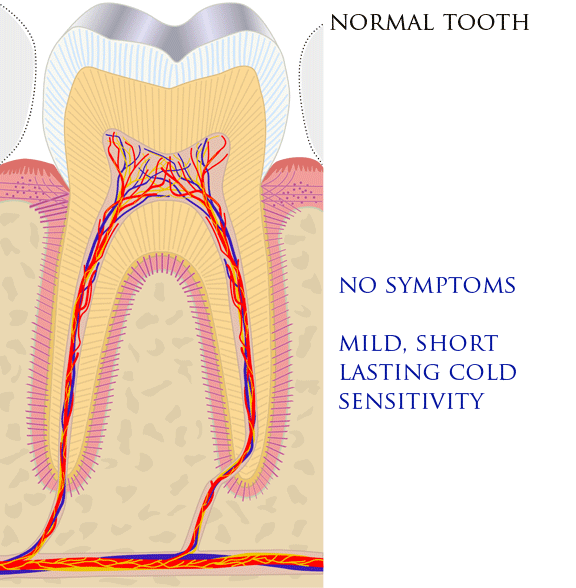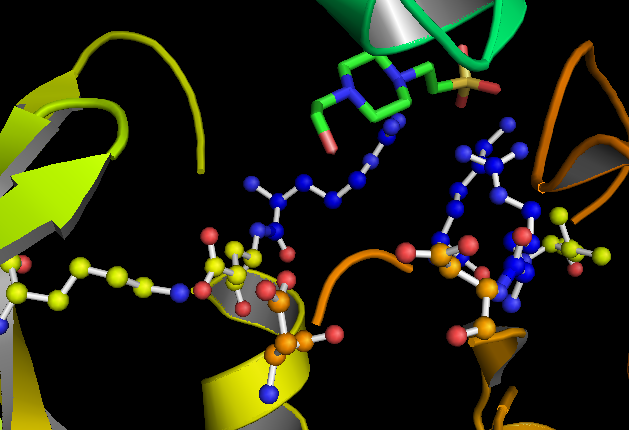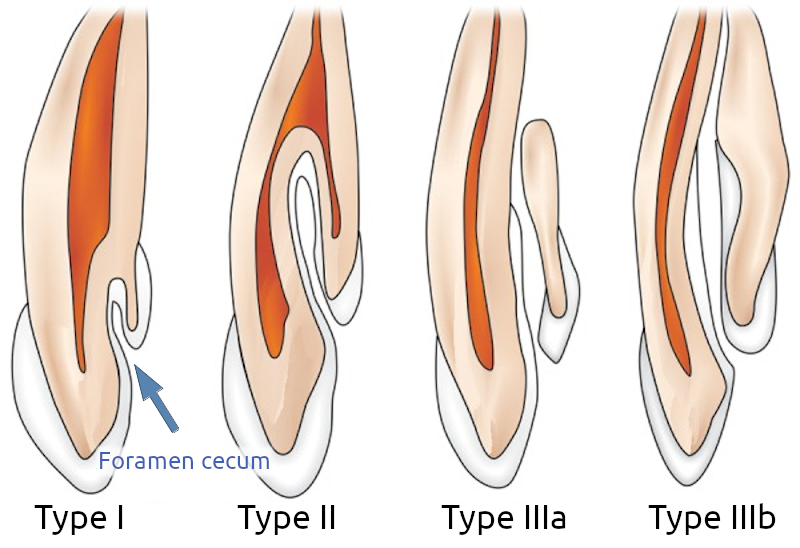|
Regenerative Endodontics
Regenerative endodontic procedures is defined as biologically based procedures designed to replace damaged structures such as dentin, root structures, and cells of the pulp-dentin complex. This new treatment modality aims to promote normal function of the pulp. It has become an alternative to heal apical periodontitis. Regenerative endodontics is the extension of root canal therapy. Conventional root canal therapy cleans and fills the pulp chamber with biologically inert material after destruction of the pulp due to dental caries, congenital deformity or trauma. Regenerative endodontics instead seeks to replace live tissue in the pulp chamber. The ultimate goal of regenerative endodontic procedures is to regenerate the tissues and the normal function of the dentin-pulp complex. Before this treatment modality is introduced, apexification procedures using either immediate placement of mineral trioxide aggregate apical plug or long term-calcium hydroxide treatment were traditionally ... [...More Info...] [...Related Items...] OR: [Wikipedia] [Google] [Baidu] |
Endodontic
Endodontics (from the Greek roots ''endo-'' "inside" and ''odont-'' "tooth") is the dental specialty concerned with the study and treatment of the dental pulp. Overview Endodontics encompasses the study (practice) of the basic and clinical sciences of normal dental pulp, the etiology, diagnosis, prevention, and treatment of diseases and injuries of the dental pulp along with associated periradicular conditions. In clinical terms, endodontics involves either preserving part, or all of the dental pulp in health, or removing all of the pulp in irreversible disease. This includes teeth with irreversibly inflamed and infected pulpal tissue. Not only does endodontics involve treatment when a dental pulp is present, but also includes preserving teeth which have failed to respond to non-surgical endodontic treatment, or for teeth that have developed new lesions, e.g., when root canal re-treatment is required, or periradicular surgery. Endodontic treatment is one of the most commo ... [...More Info...] [...Related Items...] OR: [Wikipedia] [Google] [Baidu] |
Dentin
Dentin () (American English) or dentine ( or ) (British English) ( la, substantia eburnea) is a calcified tissue of the body and, along with enamel, cementum, and pulp, is one of the four major components of teeth. It is usually covered by enamel on the crown and cementum on the root and surrounds the entire pulp. By volume, 45% of dentin consists of the mineral hydroxyapatite, 33% is organic material, and 22% is water. Yellow in appearance, it greatly affects the color of a tooth due to the translucency of enamel. Dentin, which is less mineralized and less brittle than enamel, is necessary for the support of enamel. Dentin rates approximately 3 on the Mohs scale of mineral hardness. There are two main characteristics which distinguish dentin from enamel: firstly, dentin forms throughout life; secondly, dentin is sensitive and can become hypersensitive to changes in temperature due to the sensory function of odontoblasts, especially when enamel recedes and dentin channels becom ... [...More Info...] [...Related Items...] OR: [Wikipedia] [Google] [Baidu] |
Tooth Regeneration
Tooth regeneration is a stem cell based regenerative medicine procedure in the field of tissue engineering and stem cell biology to replace damaged or lost teeth by regrowing them from autologous stem cells. As a source of the new bioengineered teeth, somatic stem cells are collected and reprogrammed to induced pluripotent stem cells which can be placed in the dental lamina directly or placed in a reabsorbable biopolymer in the shape of the new tooth. History Young et al. first demonstrated in 2002 that teeth could be regenerated from cells. See also * Epithelial cell rests of Malassez * Polyphyodont * Regenerative endodontics * Socket preservation * Tooth development Tooth development or odontogenesis is the complex process by which teeth form from embryonic cells, grow, and erupt into the mouth. For human teeth to have a healthy oral environment, all parts of the tooth must develop during appropriate st ... References Restorative dentistry Emerging technologies [...More Info...] [...Related Items...] OR: [Wikipedia] [Google] [Baidu] |
Toothache
Toothache, also known as dental pain,Segen JC. (2002). ''McGraw-Hill Concise Dictionary of Modern Medicine''. The McGraw-Hill Companies. is pain in the teeth or their supporting structures, caused by dental diseases or pain referred to the teeth by non-dental diseases. When severe it may impact sleep, eating, and other daily activities. Common causes include inflammation of the pulp, (usually in response to tooth decay, dental trauma, or other factors), dentin hypersensitivity, apical periodontitis (inflammation of the periodontal ligament and alveolar bone around the root apex), dental abscesses (localized collections of pus), alveolar osteitis ("dry socket", a possible complication of tooth extraction), acute necrotizing ulcerative gingivitis (a gum infection), and temporomandibular disorder. Pulpitis is reversible when the pain is mild to moderate and lasts for a short time after a stimulus (for instance cold); or irreversible when the pain is severe, spontaneous, an ... [...More Info...] [...Related Items...] OR: [Wikipedia] [Google] [Baidu] |
Dental Pulp Stem Cells
Dental pulp stem cells (DPSCs) are stem cells present in the dental pulp, which is the soft living tissue within teeth. They are pluripotent, as they can form embryoid body-like structures (EBs) ''in vitro'' and teratoma-like structures that contained tissues derived from all three embryonic germ layers when injected in nude mice. DPSCs can differentiate ''in vitro'' into tissues that have similar characteristics to mesoderm, endoderm and ectoderm layers. DPSCs were found to be able to differentiate into adipocytes and neural-like cells. These cells can be obtained from postnatal teeth, wisdom teeth, and deciduous teeth, providing researchers with a non-invasive method of extracting stem cells. As a result, DPSCs have been thought of as an extremely promising source of cells used in endogenous tissue engineering. Studies have shown that the proliferation rate of DPSCs is 30% higher than in other stem cells, such as bone marrow stromal stem cells (BMSSCs). These characteristics of DP ... [...More Info...] [...Related Items...] OR: [Wikipedia] [Google] [Baidu] |
GSK-3
Glycogen synthase kinase 3 (GSK-3) is a serine/threonine protein kinase that mediates the addition of phosphate molecules onto serine and threonine amino acid residues. First discovered in 1980 as a regulatory kinase for its namesake, glycogen synthase (GS), GSK-3 has since been identified as a protein kinase for over 100 different proteins in a variety of different pathways. In mammals, including humans, GSK-3 exists in two isozymes encoded by two homologous genes GSK-3α (GSK3A) and GSK-3β (GSK3B). GSK-3 has been the subject of much research since it has been implicated in a number of diseases, including type 2 diabetes, Alzheimer's disease, inflammation, cancer, addiction and bipolar disorder. GSK-3 is a serine/threonine protein kinase that phosphorylate either threonine or serine, and this phosphorylation controls a variety of biological activities, such as glycogen metabolism, cell signaling, cellular transport, and others. GS inhibition by GSK-3β leads to a decrea ... [...More Info...] [...Related Items...] OR: [Wikipedia] [Google] [Baidu] |
King's College London
King's College London (informally King's or KCL) is a public research university located in London, England. King's was established by royal charter in 1829 under the patronage of King George IV and the Duke of Wellington. In 1836, King's became one of the two founding colleges of the University of London. It is one of the oldest university-level institutions in England. In the late 20th century, King's grew through a series of mergers, including with Queen Elizabeth College and Chelsea College of Science and Technology (in 1985), the Institute of Psychiatry (in 1997), the United Medical and Dental Schools of Guy's and St Thomas' Hospitals and the Florence Nightingale School of Nursing and Midwifery (in 1998). King's has five campuses: its historic Strand Campus in central London, three other Thames-side campuses (Guy's, St Thomas' and Waterloo) nearby and one in Denmark Hill in south London. It also has a presence in Shrivenham, Oxfordshire, for its professional mi ... [...More Info...] [...Related Items...] OR: [Wikipedia] [Google] [Baidu] |
Human Tooth Development
Tooth development or odontogenesis is the complex process by which teeth form from embryonic cells, grow, and erupt into the mouth. For human teeth to have a healthy oral environment, all parts of the tooth must develop during appropriate stages of fetal development. Primary (baby) teeth start to form between the sixth and eighth week of prenatal development, and permanent teeth begin to form in the twentieth week.Ten Cate's Oral Histology, Nanci, Elsevier, 2013, pages 70-94 If teeth do not start to develop at or near these times, they will not develop at all, resulting in hypodontia or anodontia. A significant amount of research has focused on determining the processes that initiate tooth development. It is widely accepted that there is a factor within the tissues of the first pharyngeal arch that is necessary for the development of teeth. Overview The tooth germ is an aggregation of cells that eventually forms a tooth.University of Texas Medical Branch. These cells are der ... [...More Info...] [...Related Items...] OR: [Wikipedia] [Google] [Baidu] |
Dens Invaginatus
Dens invaginatus (DI), also known as tooth within a tooth, is a rare dental malformation where there is an infolding of enamel into dentine. The prevalence of condition is 0.3 - 10%, affecting more males than females. The condition is presented in two forms, coronal and radicular, with the coronal form being more common. DI is a malformation of teeth most likely resulting from an infolding of the dental papilla during tooth development or invagination of all layers of the enamel organ in dental papillae. Affected teeth show a deep infolding of enamel and dentine starting from the foramen coecum or even the tip of the cusps and which may extend deep into the root. Teeth most affected are maxillary lateral incisors Incisors (from Latin ''incidere'', "to cut") are the front teeth present in most mammals. They are located in the premaxilla above and on the mandible below. Humans have a total of eight (two on each side, top and bottom). Opossums have 18, wh ... (80%), followed by ... [...More Info...] [...Related Items...] OR: [Wikipedia] [Google] [Baidu] |
Dens Evaginatus
Dens evaginatus is a rare odontogenic developmental anomaly that is found in teeth where the outer surface appears to form an extra bump or cusp. Premolars are more likely to be affected than any other tooth. It could occur unilaterally or bilaterally. Dens evaginatus (DE) typically occurs bilaterally and symmetrically. This may be seen more frequently in Asians (including Chinese, Malay, Thai, Japanese, Filipino and Indian populations). The prevalence of DE ranges from 0.06% to 7.7% depending on the race. It is more common in men than in women, more frequent in the mandibular teeth than the maxillary teeth. Patients with Ellis-van Creveld syndrome, incontinentia pigmenti achromians, Mohr syndrome, Rubinstein-Taybi syndrome and Sturge Weber syndrome are at a higher risk of having DE. Signs and symptoms It is important to diagnose DE early and provide appropriate treatment to help prevent periodontal disease, caries, pulpal complications and malocclusion. It occurs on ... [...More Info...] [...Related Items...] OR: [Wikipedia] [Google] [Baidu] |
Platelet Rich Fibrin
Platelet-rich fibrin (PRF) or leukocyte- and platelet-rich fibrin (L-PRF) is a second-generation PRP where autologous platelets and leukocytes are present in a complex fibrin matrix to accelerate the healing of soft and hard tissue and is used as a tissue-engineering scaffold for endodontics. To obtain PRF, required quantity of blood is drawn quickly into test tubes without an anticoagulant and centrifuged immediately. Blood can be centrifuged using a tabletop centrifuge from 3-8 minutes for 1300 revolutions per minute. The resultant product consists of the following three layers; topmost layer consisting of platelet poor plasma, PRF clot in the middle, and red blood cells (RBC) at the bottom. PRF is available as a fibrin clot. PRF clot can be removed from the test tube using a sterile tweezer-like instrument. After lifting, the RBC layer attached to the PRF clot can be carefully removed using a sterilized scissor. Platelet activation in response to tissue damage occurs during th ... [...More Info...] [...Related Items...] OR: [Wikipedia] [Google] [Baidu] |
Human Tooth
The human teeth function to mechanically break down items of food by cutting and crushing them in preparation for swallowing and digesting. As such, they are considered part of the human digestive system. Humans have four types of teeth: incisors, canines, premolars, and molars, which each have a specific function. The incisors cut the food, the canines tear the food and the molars and premolars crush the food. The roots of teeth are embedded in the maxilla (upper jaw) or the mandible (lower jaw) and are covered by gums. Teeth are made of multiple tissues of varying density and hardness. Humans, like most other mammals, are diphyodont, meaning that they develop two sets of teeth. The first set, deciduous teeth, also called "primary teeth", "baby teeth", or "milk teeth", normally eventually contains 20 teeth. Primary teeth typically start to appear (" erupt") around six months of age and this may be distracting and/or painful for the infant. However, some babies are born with ... [...More Info...] [...Related Items...] OR: [Wikipedia] [Google] [Baidu] |






